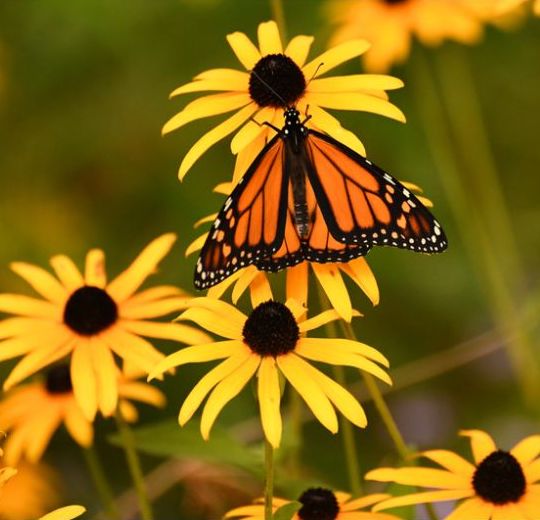
How To Attract Beneficial Insects, Busy Pollinators and Beautiful Butterflies
Share
Our gardens gain a lot of free benefits with more frequent visits from lots of pollinators, including butterflies and other beneficial insects. An easy and surefire way to lay out the welcome mat is to grow their favorite flowers, making your garden super attractive. And you get to enjoy the extra dose of beautiful besides! Here are my four favorite recommendations:
1. Black-eyed Susan
A native species, Black-eyed Susans, aka Rudbeckia, is a member of the coneflower family. Coneflowers get their name from their ‘cone-shaped’ center. They're easy to start from seed! AND a tremendous number of flies, bees, wasps, and other critters love to frequent them.
Black-eyed Susans have a ‘hidden superpower’ that makes them irresistible! The flowers boast a giant 'bullseye' for native pollinators— look closely at this picture. Can you see it?

This is the ‘bullseye circle’ around the dark center or eye of the flower head. It's an ultraviolet pigment that bees see much more intensely than our human eye does. It’s a strong visual cue that leads them to the nectar and pollen at the flower’s center.
The characteristic dark, cone-shaped flower head holds 250 to 500 individual 'flowers'. These flowers start blooming at the edges near the petals and continue blooming inward and upward. To pollinators each one of them is like a shallow cup of sweet nectar. They’re shallow enough to enable even small wasps and flies to drink from them.
It’s a buffet that attracts a wide variety of small to medium-sized pollinators, including many species of insects crucial for pest control— beneficial predators and parasitoids of many garden pest insects.

Here's a syrphid fly drinking nectar from the flower heads. These little helpers lay eggs in your garden and their larvae feed on aphids! Interplanting Black-eyed Susan near your cucumbers, beans, squash and lettuce will help control these pests. You get flowers AND helpers! How fun is that?!
2. Echinacea- Purple Coneflower
Another coneflower and not JUST another pretty flower— these gorgeous native perennials are cousins to Black-eyed Susans and are also butterfly and bird magnets! And they’re beloved as cut flowers— but leave plenty of blooms in the garden for ‘others’ to enjoy!
Like their cousins, they’re an easy care choice— they have few pests, are somewhat drought tolerant, like well-drained soils and a nice sunny spot. They’re native to the United States and are easy to grow in zones 3 – 8. AND they're perennial-- meaning they'll come back year after year with little help from you!
Coneflowers attract all types of butterflies, including Great Spangled Fritillary, Monarchs, Painted Ladies, and Swallowtails, who feed on the high quality, sweet nectar.

Birds also enjoy coneflowers in the garden. The butterflies and pollinators work the flowers to produce loads of seeds via the spent flowers. Don’t deadhead these— Blue Jays, Goldfinches, and other seed eating birds will enjoy eating the seeds. Let them stand through the winter— it’s like growing your own birdseed. When spring arrives, simply cut back your coneflowers near the ground. They’ll grow back to bloom in summer!
Plan for some of these perennial beauties sprinkled around your garden. Then enjoy the bees, butterflies, birds and more that these flowers are sure to attract!
3. California Gaint Zinnia
Zinnias—one of the best annuals for attracting pollinators! Especially butterflies! Butterflies that frequent zinnias include: Monarchs, Painted and American Ladies, Swallowtails, and Red Admirals.

Zinnias feature attractive colorful blooms and easy-to-access nectar. And they’re another easy to grow, low maintenance beauty.
If you’re looking to attract butterflies to your garden using zinnias, here’s a few tips. The taller varieties are more attractive than dwarf, compact cultivars because they have wider, flatter blooms with a larger landing surface. Double bloom varieties are more difficult for butterflies to access nectar.
California Giant is one of the varieties noted to produce a larger quantity and better quality nectar than others. We like to interplant these zinnias between rows of vegetables, along border rows, and around the vegetables to attract more pollinators to the garden along with those beneficial predators and parasitoids to control common garden pests.
Zinnia’s do prefer full sun— but can tolerate some shade if they get at least six hours of sun per day. They also tolerate many soil types and conditions. They originated in arid regions, so they love hot weather and are drought tolerant.
4. Torch Mexican Sunflower
Mexican sunflower is hands down the most ‘active’ pollinator plant you can grow in your garden. This annual plant can grow over 7 feet tall! Hard to believe an annual plant can grow so large in a single season! And it’s LOADED with blooms— attractive and active blooms. Butterflies and bees are constant visitors! As an added bonus— expect a few hummingbirds to come a-callin’ too!

This annual blooms nonstop from mid-summer to frost, attracting butterflies, bees, hummingbirds, and beneficial insects, such as hover flies and pirate bugs. Deadheading spent flowers will increase the number of blooms but is not essential. It’s also a beautiful cut flower, commonly known as clavel de muerto.
Mexican Sunflowers thrive best in full sun but will tolerate half sun. It prefers poor to average, well drained soils; high fertility causes more vegetative growth with fewer blooms, so do not over fertilize. Loves hot, dry weather! Once established, this is a very low-maintenance plant.
Those are our best picks for frequent butterfly visits along with all our pollinator and beneficial friends! Enjoy!
Our best to you,
Theresa
